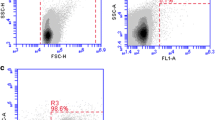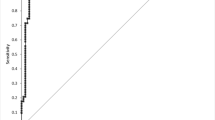Abstract
Purpose
Culture-negative urine specimens can be rapidly screened by urine flow cytometry (UFC), while low positive predictive value (PPV) limits the clinical application. We explored the factors associated with a low PPV.
Methods
A total of 5095 urine specimens were analyzed with UFC and culture. Diagnostic performance of leukocytes, bacteria, and BACT-info flags was evaluated by sensitivity, specificity, PPV, and negative predictive value (NPV). The association of contaminated culture and squamous epithelial cell count and BACT-info flag was performed by logistic regression analysis.
Results
The NPVs of parallel combination of bacteria and leucocytes were 98.9% in males and 97.9% in females, and PPVs of serial combination were 86.6% and 77.8% in men and women, respectively. The PPV of Gram-negative flag was higher than that of Gram-positive flag. The proportions of contamination in the urine culture results of false positive specimens were 86.9% in males and 98.5% in females at the cutoff points of the serial combination, and these parameters were 53.2% in males and 85.6% in females for the Gram-positive flag. There was a statistically significant association between contaminated cultures and squamous epithelial cells count in females, but not in males. Associations between contaminated cultures and Gram-positive flags or Gram-pos/-neg flags were statistically significant, but there was no association between contaminated cultures and Gram-negative flags.
Conclusions
A serial combination of leukocytes and bacteria may maximize PPV in the diagnosis of bacterial urinary tract infection by urine flow cytometry, and contamination is the main reason for a low PPV.


Similar content being viewed by others
References
Foxman B (2010) The epidemiology of urinary tract infection. Nat Rev Urol 7(12):653–660
Venkatesan A, Oto A, Allen B, Akin O, Alexander L, Chong J, Froemming A, Fulgham P, Goldfarb S, Gettle L, Maranchie J, Patel B, Schieda N, Schuster D, Turkbey I, Lockhart M (2020) ACR appropriateness criteria® recurrent lower urinary tract infections in females. J Am Coll Radiol 17:S487–S496
Kaur R, Kaur R (2021) Symptoms, risk factors, diagnosis and treatment of urinary tract infections. Postgrad Med J 97(1154):803–812
Oyaert M, Van Meensel B, Cartuyvels R, Frans J, Laffut W, Vandecandelaere P, De Beenhouwer H (2018) Laboratory diagnosis of urinary tract infections: towards a BILULU consensus guideline. J Microbiol Methods 146:92–99
Bunjevac A, Gabaj N, Miler M, Horvat A (2018) Preanalytics of urine sediment examination: effect of relative centrifugal force, tube type, volume of sample and supernatant removal. Biochem Med 28(1):010707
Geerts N, Jansz A, Boonen K, Wijn R, Koldewijn E, Boer A, Scharnhorst V (2015) Urine flow cytometry can rule out urinary tract infection, but cannot identify bacterial morphologies correctly. Clin Chim Acta Int J Clin Chem 448:86–90
Herráez O, Asencio M, Carranza R, Jarabo M, Huertas M, Redondo O, Arias-Arias A, Jiménez-Álvarez S, Solís S, Zamarrón P, Illescas M, Galán M (2018) Sysmex UF-1000i flow cytometer to screen urinary tract infections: the URISCAM multicentre study. Lett Appl Microbiol 66(3):175–181
Wilson M, Gaido L (2004) Laboratory diagnosis of urinary tract infections in adult patients. Clin Infect Dis Off Publ Infect Dis Soc Am 38(8):1150–1158
Seghezzi M, Manenti B, Previtali G, Alessio M, Dominoni P, Buoro S (2017) Preliminary evaluation of UF-5000 body fluid mode for automated cerebrospinal fluid cell counting. Clin Chim Acta Int J Clin Chem 473:133–138
Haugum K, Haugan MS, Skage J, Tetik M, Jakovljev A, Nilsen H-JS, Afset JE (2021) Use of Sysmex UF-5000 flow cytometry in rapid diagnosis of urinary tract infection and the importance of validating carryover rates against bacterial count cut-off. J Med Microbiol 70(12):001472
Ippoliti R, Allievi I, Rocchetti A (2020) UF-5000 flow cytometer: a new technology to support microbiologists’ interpretation of suspected urinary tract infections. Microbiologyopen 9(3):e987
Ortiz de la Tabla V, Gázquez G, Infante A, Martin C, Buñuel F, Gutiérrez F (2019) Performance of the cobas u 701 analyzer in urinary tract infection screening. Ann Lab Med 39(5):464–469
Kim SY, Park Y, Kim H, Kim J, Koo SH, Kwon GC (2018) Rapid screening of urinary tract infection and discrimination of gram-positive and gram-negative bacteria by automated flow cytometric analysis using Sysmex UF-5000. J Clin Microbiol 56(8):e02004–17
Alenkaer LK, Pedersen L, Szecsi PB, Bjerrum PJ (2021) Evaluation of the sysmex UF-5000 fluorescence flow cytometer as a screening platform for ruling out urinary tract infections in elderly patients presenting at the emergency Department. Scand J Clin Lab Invest 81(5):379–384
Wang H, Han F, Wen J, Yan Z, Han Y, Hu Z, Zheng W (2023) Accuracy of the Sysmex UF-5000 analyzer for urinary tract infection screening and pathogen classification. PLoS One 18(2):e0281118
Ren C, Wu J, Jin M, Wang X, Cao H (2018) Rapidly discriminating culture-negative urine specimens from patients with suspected urinary tract infections by UF-5000. Bioanalysis 10(22):1833–1840
Maher P, Jablonowski K, Richardson L (2020) Squamous epithelial cell presence reduces accuracy of urinalysis for prediction of positive urine cultures. Am J Emerg Med 38(7):1384–1388
Previtali G, Ravasio R, Seghezzi M, Buoro S, Alessio M (2017) Performance evaluation of the new fully automated urine particle analyser UF-5000 compared to the reference method of the Fuchs-Rosenthal chamber. Clin Chim Acta Int J Clin Chem 472:123–130
Enko D, Stelzer I, Bockl M, Schnedl WJ, Meinitzer A, Herrmann M, Totsch M, Gehrer M (2021) Comparison of the reliability of gram-negative and gram-positive flags of the Sysmex UF-5000 with manual gram stain and urine culture results. Clin Chem Lab Med 59(3):619–624
Gilboe HM, Reiakvam OM, Aasen L, Tjade T, Bjerner J, Ranheim TE, Gaustad P (2021) Rapid diagnosis and reduced workload for urinary tract infection using flowcytometry combined with direct antibiotic susceptibility testing. PLoS One 16(7):e0254064
Müller M, Sägesser N, Keller P, Arampatzis S, Steffens B, Ehrhard S, Leichtle A (2022) Urine flow cytometry parameter cannot safely predict contamination of urine-a cohort study of a Swiss emergency department using machine learning techniques. Diagnostics (Basel, Switzerland) 12(4):1008
Smith P, Morris A, Reller L (2003) Predicting urine culture results by dipstick testing and phase contrast microscopy. Pathology 35(2):161–165
Author information
Authors and Affiliations
Contributions
GZ, ZD, X-ML and MC: conceptualized the study. GZ, MC, YY, YG and XY: collected, analyzed and interpreted the data. GZ and X-ML: conducted the statistical analysis. GZ and ZD: wrote the first draft of the manuscript. All authors revised the manuscript and approved the final version.
Corresponding authors
Ethics declarations
Conflict of interest
The authors declare no competing interests.
Ethical approval
No patient specific privacy information is involved, and no patient intervention occurred with the obtained results, therefore do not involve ethics approval.
Additional information
Publisher's Note
Springer Nature remains neutral with regard to jurisdictional claims in published maps and institutional affiliations.
Rights and permissions
Springer Nature or its licensor (e.g. a society or other partner) holds exclusive rights to this article under a publishing agreement with the author(s) or other rightsholder(s); author self-archiving of the accepted manuscript version of this article is solely governed by the terms of such publishing agreement and applicable law.
About this article
Cite this article
Zhang, G., Dai, Z., Yao, Y. et al. Analysis of factors with low positive predictive value in the diagnosis of urinary tract infection by flow cytometry. World J Urol 41, 3611–3618 (2023). https://doi.org/10.1007/s00345-023-04676-6
Received:
Accepted:
Published:
Issue Date:
DOI: https://doi.org/10.1007/s00345-023-04676-6




